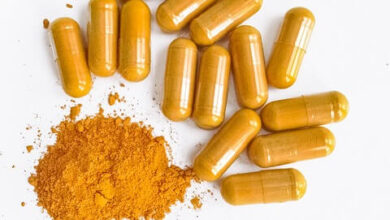The Amazing Health Benefits of Tulsi/Holy Basil, the Queen of Herbs

Tulsi, also known as Holy Basil, has been used in India for thousands of years. This sacred herb is extremely popular in Ayurvedic medicine and is revered for its healing properties. Tulsi is considered an adaptogen, meaning it can help the body adapt and respond to stress. The scent, flavour, and medicinal qualities of Tulsi make it one of the most cherished herbs. Read on to learn all about Tulsi and how you can harness its many health benefits.
Table of Contents
What is Tulsi/Holy Basil?
Botanical Information
Tulsi belongs to the mint family, which includes other herbs like rosemary, sage, basil and oregano. There are three main varieties of Tulsi: Krishna Tulsi, Rama Tulsi, and Vana Tulsi. The species name for Krishna and Rama Tulsi is Ocimum tenuiflorum, while Vana Tulsi has the species name Ocimum gratissimum.
Tulsi is native to the tropical and subtropical regions of India, as well as areas of East Africa and parts of Asia. It thrives in warm, humid climates but can also grow well in more temperate environments.
Spiritual and Cultural Significance in India
In the Hindu religion, Tulsi is considered a manifestation of the goddess Lakshmi, the wife of the god Vishnu. Tulsi plays an important role in spiritual ceremonies and is a symbol of devotion. Its wood and oils are used to make malas (prayer beads) and its leaves are used in puja (worship) rituals.
In Ayurvedic medicine, Tulsi is known as “The Incomparable One” and “The Mother of All Herbs”. It has been used for over 5,000 years due to its medicinal properties and purifying effects. Tulsi is believed to promote purity and cleanse the mind, body and spirit.
Small Tulsi plants can be found growing in courtyards of Hindu homes and temples across India. Its pleasant aroma is thought to keep away insects and purify the surrounding air.
Read More: The Life Plant: Health Benefits and Uses of Bryophyllum Pinnatum
Different Varieties of Tulsi/Holy Basil
There are four main types of Tulsi that each have slightly different properties:
Krishna Tulsi- This variety has a purple tint to the leaves and stems. It is thought to have the most potency and medicinal value. The scent is crisp and clove-like.
Rama Tulsi- This green leaf variety has a lemon scent. It is known for its cooling and mellow flavour.
Vana Tulsi- Also called wild leaf tulsi, vana tulsi is known for its fragrance and medicinal value. The leaves have a crisp, minty aroma.
Africanum Tulsi- Sometimes called “temperate tulsi”, this variety grows well in cooler, humid climates. The scent is earthy and less crisp.
Health Benefits of Tulsi/Holy Basil
Tulsi has been used in Ayurvedic medicine for thousands of years due to its many therapeutic properties. Here are some of the top health benefits:
Nervous System Support
Tulsi has adaptogenic properties that help boost energy levels, increase focus and concentration, and relieve anxiety and stress.
1. The bioactive compounds promote a sense of calm and peace. They interact with neurotransmitters in the brain to reduce anxiety and emotional stress.
2. Tulsi is an excellent herb for adrenal fatigue. It helps stabilize cortisol levels and regulate the body’s stress response.
3. Tulsi has been shown to enhance memory, cognitive function and reaction time. It can help relieve brain fog caused by stress or menopause.
4. The soothing, sedative properties of tulsi help treat insomnia, restless sleep and other sleep disorders. It promotes deeper, more restorative sleep.
Read More: The Versatile Uses and Benefits of Palm Grass
Digestive System Relief
Tulsi helps stimulate digestion, reduce bloating and gas, and treat many gastrointestinal disorders.
1. It increases the production of gastric juices to improve digestion and nutrient absorption.
2. Tulsi reduces intestinal spasms and cramps. The antispasmodic activity provides quick relief from abdominal pain.
3. Tulsi exhibits anti-ulcer activity that protects the gastric mucosal lining and inhibits ulcer development.
4. The antibacterial properties help kill harmful pathogens like E. coli, H. pylori, and salmonella that can cause food poisoning.
5. Clinical studies show tulsi can help relieve viral hepatitis and diarrhoea caused by viral infections.
Adaptogenic Properties
Tulsi potentiates the body’s ability to adapt and resist the damaging effects of ongoing stress.
1. It normalizes cortisol levels, heart rate, blood pressure and other stress biomarkers. This protects organ tissues against the oxidative damage caused by chronic stress.
2. Tulsi enhances stamina and endurance. Regular use can prevent adrenal exhaustion from exertion and physical stressors.
3. The immunomodulatory action enhances immune function against infection while also exerting anti-inflammatory activity.
Read More: How Jack Beans Can Improve Your Health
How to Use Tulsi/Holy Basil
There are many easy and delicious ways to add tulsi to your health and wellness routine:
Tulsi Tea
Tulsi tea is one of the most popular uses for this incredible herb. Try adding these blends to hot water for a soothing, medicinal tea:
Simple Tulsi Infusion- Add 2-3 teaspoons fresh or dried tulsi leaves to 8oz hot water. Steep for 5-7 minutes. Add lemon or honey if desired.
Tulsi Ginger Lemon Tea- Combine tulsi leaves, freshly grated ginger, and lemon juice with hot water. This is an excellent remedy for colds and congestion.
Tulsi Rose Tea- For a floral, aromatic tea, combine tulsi leaves with dried rose petals. This blend lifts the mood and spirit.
Tinctures and Oils
Tulsi Tincture- A tulsi tincture made with fresh leaves and flowers retains many of the plant’s bioactive compounds. Take 30-60 drops mixed with water or tea 1-3x daily.
Tulsi Essential Oil- Use a few drops of distilled tulsi oil in a diffuser or mix with a carrier oil for topical use. Inhale the oil or apply it to the temples, back of the neck or wrists.
Read More: Papaturro: A Comprehensive Guide to the Nutritious Central American Fruit
Oxymels
An oxymel is a medicinal syrup made with vinegar and honey. To make a tulsi oxymel:
1. Combine 1 cup apple cider vinegar with 1 cup fresh tulsi leaves. Allow to infuse for 2 weeks, strain and discard herbs.
2. Add 1 cup of honey and stir to combine. Keep refrigerated and take 1-2 tbsp daily.
Infused Water
For a delicious summertime beverage, add tulsi leaves and mint leaves to a pitcher of water. Allow the herbs to infuse overnight in the fridge to extract their beneficial compounds.
Growing Tulsi at Home
Growing your tulsi plants allows you to reap the rewards of this incredible herb. Here’s how to cultivate tulsi:
1. Tulsi grows best in warm tropical or subtropical climates, but some varieties can thrive in cooler zones with the right care. Provide lots of sun and well-drained soil.
2. Start seeds indoors 6-8 weeks before the last frost. Soak seeds in water for 24 hours before sowing. Transplant seedlings outside after hardening off.
3. Space tulsi plants 12-24 inches apart in the garden. Enrich the soil with compost and keep consistently moist.
4. Pinch off flower buds to prolong leaf and stem growth. Harvest leaves and stems throughout the growing season.
5. At the end of the season, allow some plants to flower and drop seeds. Collect seeds to plant the following season.
6. In temperate climates, grow tulsi in containers that can be brought indoors over winter. Place in a sunny window and reduce watering.
Read More: The Complete Guide to Didier’s Tulip: Scientifically as Tulipa Gesneriana
Harvesting, Drying and Storing Tulsi/Holy Basil
1. Harvest tulsi when the plants reach 1-2 feet tall. Cut stems near the base of the plant.
2. Rinse harvested stems and leaves. Pat dry thoroughly with towels. Discard any damaged leaves.
3. Dry tulsi leaves quickly by placing them in a single layer on dehydrator trays or hanging bundles upside down in a warm, dark place.
4. Leaves are fully dry when they crumble easily between the fingers. Store dried leaves in airtight glass jars.
5. Dried tulsi leaves will retain their aroma and potency for up to 12 months. Use within a year for the best medicinal value.
Read More: Borojo: The Exotic Fruit with Untapped Health Potential
Precautions and Side Effects of Holy Basil/Tulsi
Despite its many benefits, tulsi does come with some precautions:
1. Tulsi may slow blood clotting, so should be avoided 2 weeks before scheduled surgery.
2. Discontinue use during pregnancy due to possible uterine stimulant effects.
3. Tulsi may interfere with fertility and should not be taken when trying to conceive.
4. Due to its hypoglycemic activity, tulsi may lower blood sugar levels. Monitor closely if diabetic.
5. Allergies to basil, mint or other herbs in the Lamiaceae family are possible. Discontinue if signs of an allergic reaction occur.
Read More: Marula Fruit Magic: Boost Your Health Naturally
Conclusion
With its rich history, spiritual significance, intoxicating aroma and incredible therapeutic benefits, it’s clear why Tulsi has earned the name “Queen of Herbs”. Adding tulsi to your health and wellness routine provides a myriad of benefits, from relieving stress to enhancing respiratory function and digestion. Whether enjoyed as a tea, tincture, essential oil or fresh herb, tulsi is an easy and tasty way to improve your overall health.
FAQs
Q1: What is the best variety of Tulsi to grow at home?
A1: Krishna Tulsi and Rama Tulsi are two excellent choices for home gardens. They are holy basil varieties that contain high levels of beneficial compounds like eugenol, ursolic acid, and rosmarinic acid. These purple and green leaf varieties also have a robust, spicy aroma.
Q2: How often should I drink Tulsi tea?
A2: Tulsi tea can be enjoyed 1-2 times daily. It’s best to avoid drinking excessive amounts of tulsi tea. Have 1-2 cups per day to receive the energizing and restorative benefits. Tulsi is generally safe used in moderation, but high doses may have adverse effects.
Q3: Can I take Tulsi if I’m pregnant?
A3: No, Tulsi is not considered safe for pregnant women. Animal studies show it may stimulate contractions, so it is best avoided during pregnancy. Breastfeeding women should also refrain from taking tulsi. Consult your physician before use if pregnant, breastfeeding or trying to conceive.
Q4: What’s the best way to store dried Tulsi leaves?
A4: To retain the highest potency and shelf life, store dried tulsi leaves in airtight glass jars away from light and heat. Keep in a cool, dark place and avoid humidity. Stored properly, dried tulsi leaves will remain fresh for up to 12 months before losing potency. Mark the date of harvest on the jar.
Disclaimer:
This article is only written for basic and general informational purposes only. The Statements contained here have not been evaluated by the FDA and neither the efficacy of these products has been confirmed by FDA-approved research. All information presented here is not meant as a substitute for or alternative to information from health care practitioners.
There’s no guarantee of specific results and the results can vary. Users must not view the content as medical advice in any way. Users are also required to ’NOT SELF-MEDICATE’ and always consult their health care professional before taking any medicines or undergoing any treatment. DivyaAyushCare and the author will not be responsible for any act or omission by the User arising from the User’s interpretation of the content. I am not a doctor and nothing in this article is medical advice.




